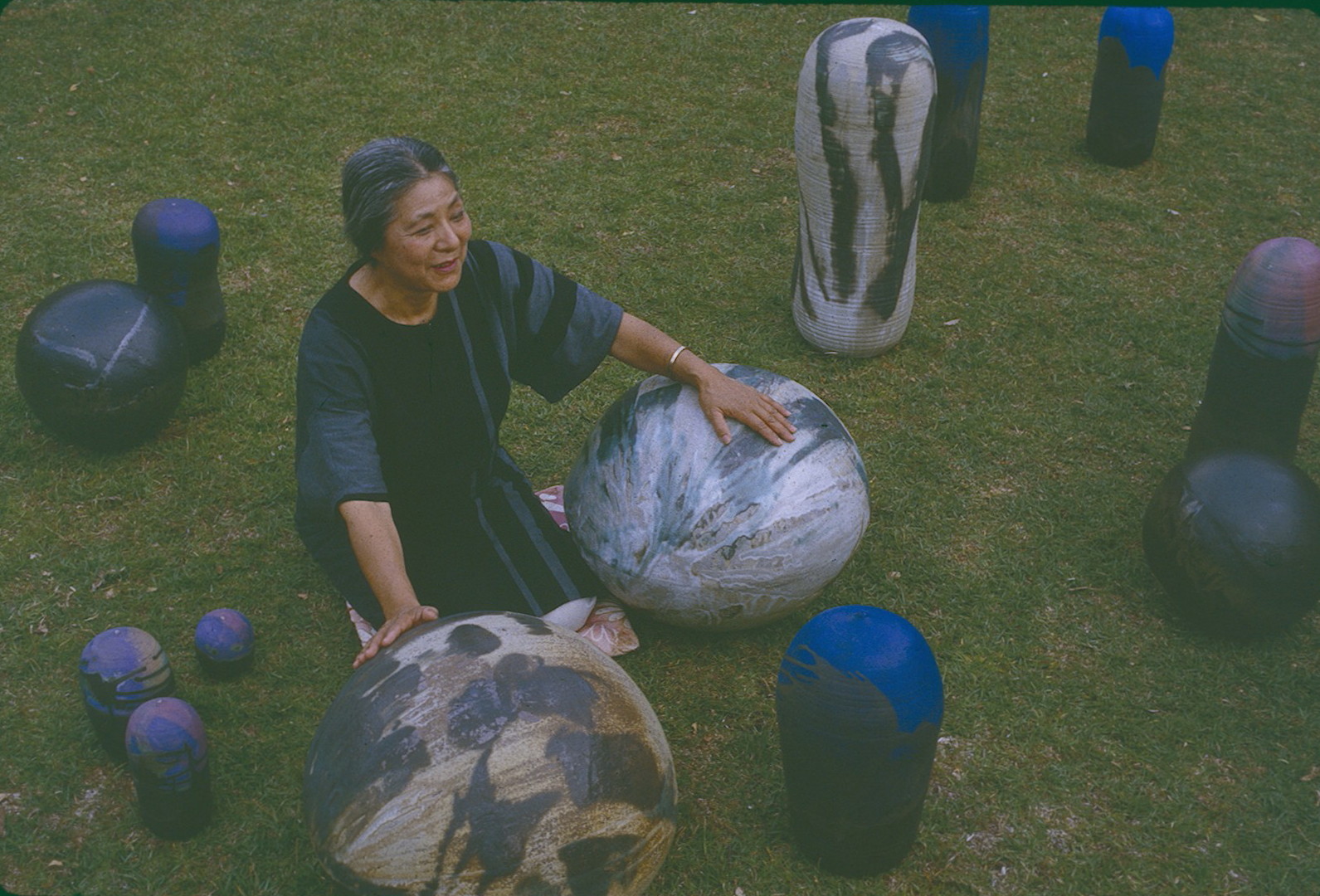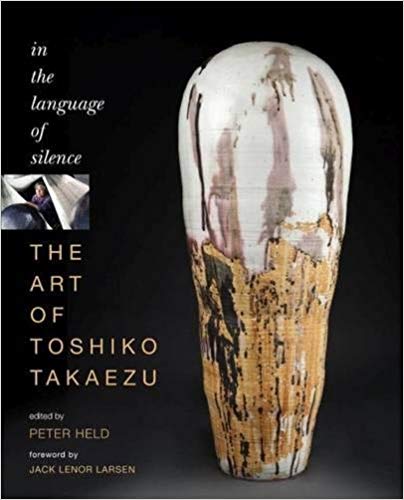Toshiko Takaezu
Photographer unknown
Toshiko Takaezu (1922-2011) was one of the twentieth century’s greatest abstract artists. Gifted with prodigious drive and vision, she combined inspirations from her own cultural background with currents from contemporary painting and sculpture, arriving at a unique expressionist idiom.
Born in Hawaii to a Japanese émigré family, Takaezu received her early training in ceramics in Honolulu, and then attended Cranbrook Academy in Michigan, when it was an epicenter for adventurous modernism. Already in this early phase in her career, she was able to see correspondences between Abstract Expressionism and the spiritually infused traditions of East Asia, such as calligraphy and tea ceremony. She combined these cross-cultural influences into a powerfully resolved synthesis.
Though made using traditional pottery techniques of wheel-throwing and glazing, the works for which she is best known – the closed forms – are best understood as sculptures, or perhaps as paintings-in-the-round. They are as individual as people are, varying greatly in scale and shape, color and texture, and in their internal tectonic rhythms. Some are vigorously painterly, with splashes and rivulets of color coursing down their sides. Others are more meditative, sheathed in overlapping veils of hue. They have a close affinity with the work of other postwar expressionist artists, such as Franz Kline, Joan Mitchell, and Mark Rothko.
Takaezu was also a great experimenter. In her early career she expanded the possibilities of the vessel, exploring multiple spouts and lobed forms, and made plates that were essentially canvases for freeform composition. Later innovations included upright cylindrical vessels she called “trees,” anthropomorphic forms with strong shouldered profiles, bronze castings, and slitted-open sculptures (also known as “Momos”) that afford a glimpse into their dark interiors. Throughout her career, Takaezu also pursued media apart from ceramics, including large-scale textiles and paintings, which extended her vocabulary of vivid chromatic abstraction.
Last but by no means least, Takaezu was a profoundly influential teacher and mentor, who trained generations of younger artists at the Cleveland Institute of Art, Princeton University and other institutions. Her legacy lives on in these students and apprentices, and above all in her own work, which both exemplifies and transcends the ideals of modernist ceramic art.
GLENN ADAMSON
Independent Scholar and Curator
Biography
Photo Credit : Macario Timbal, 1987
American artist Toshiko Takaezu (1922–2011) was born in Pepeekeo, Hawaii to Japanese immigrant parents Shinsa and Kama Takaezu. One of eleven children, she was raised in a traditional Japanese household whose values, as well as the surrounding Hawaiian landscape, strongly underscore her artistic practice. During her five-decade-long career, the artist worked in many media including painting, fiber, and bronze. However, her primary medium, and that for which she is best recognized, was ceramics. Takaezu was instrumental in the post-war reconceptualization of ceramics from the functional craft tradition to the realm of fine art. Her signature “closed form” merged the base form with glazed surface painting to create a unified work.
Prior to exploring clay’s aesthetic potential, Takaezu first encountered the material in a utilitarian context in 1940 while working at a commercial ceramic studio in Honolulu, the Hawaii Potter’s Guild. There, she not only honed her technical skills but also met Lieutenant Carl Massa who served in the in Special Services division of the US Army. Massa gave her sculpture lessons and inspired her to read, attend cultural events, and open herself to a creative life. After attending painting classes at the Honolulu Academy of Arts, Takaezu studied ceramics with Claude Horan at the University of Hawaii (1945–47). She moved to the mainland to attend Cranbrook Academy of Art in Bloomfield Hills, Michigan (1951–54), where she studied with Maija Grotell, an acclaimed Finnish artist. Grotell was an influential figure in the development of Takaezu’s rigorous artistic practice and teaching philosophy. Grotell instilled in her the importance of the individuality of the artist’s self-discovery and self-expression, principles that Takaezu carried through the entirety of her life’s work. With the intention of connecting with her Eastern heritage, in 1955, the artist traveled in Japan for eight months. This proved to be another formative experience for her artistic development as she was impressed by both traditional and avant-garde ceramic techniques and aesthetics, meeting eminent artists Toyo Kaneshige and Yagi Kazuo, among others. While there, Takaezu also studied the tea ceremony and Zen Buddhism.
Takaezu’s formal and informal education fostered myriad themes that repeatedly emerge in her work, including the intersection of East and West as well as tradition and innovation, the Japanese tea ceremony, nature, and the seamless integration of art and life. They are most perceptible in the formal qualities and titles of her ceramic works. At times wheel-thrown or hand built, stoneware or porcelain, her sculptures range in form, size, and color. Following the utilitarian vessels and pots of her early years, the artist progressively abstracted her forms to arrive at her signature rounded, closed form. With only a nipple-like opening at their top to allow gases to escape during the firing process, Takaezu rendered these forms non-functional. The result is a sculptural form than can be appreciated strictly for its aesthetic value. The initial closed forms inspired a range of sculptural investigations such as her Moon and Tree series.
Many of these works are intimately scaled to the human hand while others soar up to six feet in height, necessitating the use of scaffolding to build them. Takaezu generated a complex relationship between the volume of three-dimensional form and the wrapped exterior surface by experimenting with glaze, which she applied freely via dripping, splashing, pouring, and brushing. The resulting painterly marks exhibit at once a deliberateness as well as an openness to chance. Additionally, they are a record of the artist’s movement as Takaezu physically circumvented the large works and manually rotated the smaller ones while she painted with glaze, a technique that the artist herself likened to dance.
Photo credit : John Paul Miller, late 1960s, courtesy of the American Craft Council
The artistic principle of integrating form and glaze also relates to that of balancing the interiority of the object with its visible façade. Despite the painted surfaces’ vivid colors and complex compositions, the dark interiors were just as important and intriguing to Takaezu. The enclosed space—as metaphor for the human spirit, or as an evocation of its own micro universe—is unseen yet still has a powerful and mysterious presence. It is literally amplified by the small clay beads that the artist often placed inside the form, which musically rattle when one handles the artwork. In this way, Takaezu’s work engages multiple senses simultaneously, which was a predominate concept in the Cranbrook curriculum while she was a student there.
This emphasis on sense of self and personal expression undergirded the artist’s creative practice and teaching career. For decades, Takaezu nurtured students’ processes of self-discovery. Beginning with teaching summer sessions at Cranbrook (1954–56), at the invitation of Grotell, Takaezu proceeded to hold positions at University of Wisconsin, Madison (1954–55), Cleveland Institute of Art (1955–64), and Princeton University (1967–92). Upon establishing her Quakertown, New Jersey studio in 1975, Takaezu began formally mentoring young artists through an immersive, live-in apprenticeship. During the year-long experience, she would instill in the apprentices her technical rigor, aesthetic principles, and synergistic approach to art and life. Today, her home is preserved as the Toshiko Takaezu Studio and continues to be used as a creative workplace by students and artists alike.
Throughout the artist’s lifetime, her work was exhibited widely in the United States and Japan, including a solo exhibition at the Philadelphia Museum of Art (2004) and a retrospective at the National Museum of Modern Art in Kyoto, Japan (1995). Takaezu was the recipient of a McInerny Foundation Grant (1952), Tiffany Foundation Grant (1964), National Endowment for the Arts Fellowship (1980), Watershed Legends Award (2007), and Konjuhosho Award (2010). Additionally, she was named a Living Treasure of Hawaii in 1987 and received the National Living Treasure Award from the University of North Carolina in 1994. Takaezu received honorary doctorate degrees from Lewis and Clark College (1987), Moore College of Art and Design (1992), University of Hawaii (1993), Princeton University (1996), and Skidmore College (2004). The artist is the subject of numerous publications including journal essays, exhibition catalogs, and monographs and her work is represented in many museum collections including the Art Institute of Chicago, DeYoung/Fine Arts Museum of San Francisco, Honolulu Museum of Art, Los Angeles County Museum of Art, The Metropolitan Museum of Art, New York, Museum of Fine Arts, Boston, and Smithsonian American Art Museum. Takaezu passed away in Honolulu on March 9, 2011.
AMELIA RUSSO
Art Historian
view chronology (1992-2011)
view awards & Grants (1952-2010)
selected publications
Toshiko Takaezu: Worlds Within
Edited by Glenn Adamson, Dakin Hart and Kate Wiener
Contributions by Ai Fukunaga, Nonie Gadsden, Diana Jocelyn Greenwold, Laura Kina, Leilehua Lanzilotti, Margo Machida, Laura Mott and Katy Siegel
An expansive look at the multifaceted American artist Toshiko Takaezu within the history of postwar artmaking
This book provides the first retrospective assessment of Takaezu’s art and life, representing her diverse oeuvre, which spanned six decades, and her hybrid identity as an Asian American woman, artist, and teacher. This ambitious volume features essays exploring Takaezu’s biography, her background as a Hawai‘i-born artist of Okinawan heritage, the relationship between her abstract work and that of her contemporaries, the role of cultural exchange in her art, her impact as an educator, and more. Beautifully illustrated with nearly 300 images of artworks and archival photographs, and including an updated chronology, exhibition history, and recollections from the artist’s former apprentices, the book offers a compelling and comprehensive account of this singular artist’s career.
The Art of Toshiko Takaezu: In the Language of Silence - Peter Held
Tracing the artistic development of renowned potter Toshiko Takaezu (1922-2011), this masterful study celebrates and analyzes an artist who held a significant place in the post-World War II craft movement in America.
Toshiko takaezu: Earth in bloom - Stanley Yake
“Born in Hawaii in 1922, Toshiko Takaezu has been working with pottery for over fifty years. Today, she is considered one of the finest ceramic artists in the world. Early in her career, Takaezu developed an approach to art that combines techniques and sensibilities of both East and West. In the 1950s, she studied in Japan with master potter Toyo Kaneshige and in 1967 began teaching at Princeton University, which awarded her an honorary doctorate in 1996. Takaezu’s distinctive art is represented in major collections throughout the world, including the permanent collections of the Smithsonian Institution, the Metropolitan Museum of Art, Boston's Museum of Fine Arts, the Art Institute of Chicago, and the American Craft Museum. Among the many other public honors she has received are the “Human Treasure Award” from the University of North Carolina, the New Jersey Governors Award, and Hawaii's “Living Treasure" Award.”
“Echoes of the Earth: Ceramics by Toshiko Takaezu showcases the art of America's greatest modern female ceramic artist. Featuring more than 50 of her signature “pots,” as Takaezu refers to them, the show highlighted a gift from the artist to the Crocker Art Museum's permanent collection. This book is a gorgeously-produced commemorative catalog of the exhibition. “The Crocker is proud to be the recipient of 32 works by Toshiko Takaezu,” said Lial Jones, Museum Director. “This gift represents a complete survey of this significant artist's work joining the Museum's ever-growing collection of international ceramics.” Takaezu's signature closed-mouth forms push the limits of the clay vessel beyond the realm of utility. No longer able to contain, her forms lose their utilitarian meaning and communicate as pure art.”
Film/Videos
POTTERS OF THE USA, PART II ( 8:23 - 13:04 )
Reelsville, IN: Peeler Ceramic Art Films, 1969
"ARTISTS OF HAWAI’I" - Show # 8 (Toshiko Takaezu), State of Hawaii Department of Education, 1984
TOSHIKO TAKAEZU : PORTRAIT OF AN ARTIST
NJN Video, Trenton NJ : NJN Television, 1993
AN INTERVIEW WITH TOSHIKO TAKAEZU
D.B Long Film, 2009
Recently discovered: Toshiko Takaezu: In the Stars (2006) NJ State of the Arts
REMEMBERING TOSHIKO
Ben Eberle, YouTube, March 10, 2011
A PERSONAL PROCESS
Ellie Jeffers, Gahanna, OH, 2018
Crafts in America, Johnson Wax Company, Documentary film on American craft artists, ABC Network, Spring, 1970
Yu-Me; Toshiko Takaezu, Photographed by Richard Francis, edited by Linda Marmelstein, music by Clinton Elliott, 1972
Clay with Toshiko Takaezu, North Bergen, NJ: Hudson Video Productions, 1974
Toshiko Takaezu at Home, Hunterdon Museum of Art, Clinton, NJ: Martin Lucas Media, 1998
Toshiko Takaezu: A Potter’s Work, A. Mori, 1998
periodicals/newspapers
Brown, Conrad. “Toshiko Takaezu.” Craft Horizons 19 (March 1959): 22–26.
Clark, Phyllis Blair. “Toshiko Takaezu Workshop.” Ceramics Monthly 45 (March 1997): 12.
Ellison, Robert A. “Philadelphia rolls out the clay.” American Craft 52 (June/July 1992): 36–45.
Hurley, Joseph. “Toshiko Takaezu: Ceramics of Serenity.” American Craft (Oct/Nov 1979): 3–9.
Kangas, Matthew. “Toshiko Takaezu.” Sculpture (March 1998): 66. Kessler, Jane. “Content.” Art Papers (Nov/Dec 1992): 2–5.
Koplus, Janet. “An Unsaid Quality”. Ceramics Monthly (March 2011): 38-43.
Levin, Elaine. “Los Angeles:ToshikoTakaezu: Japanese American National Museum.” Sculpture 25: 2 (March 2006), 68–9.
Lovelace, Joyce. “Carter’s World.” American Craft (Feb/March 1994): 22.
Lynn, Vanessa. “Rounder than Round: The Closed Forms of Toshiko Takaezu.” American Ceramics 8:4 (1990): 18–25.
Merino, Tony Dubis. “Form and Energy: The Work of Toshiko Takaezu.” Ceramics Monthly (March 1998): 37–38.
Meyer, Susan E. “The Pottery of Toshiko Takaezu.” American Artist (February 1969): 42–47.
Schlanger, Jeff. “Toshiko Takaezu at Home.” Studio Potter (June 1999): 46–52.
Schmidt, James. “Toshiko Takaezu.” Ceramics Monthly (January 1990): 36–37.
Targan, Barry. “Toshiko Takaezu: Outer Quiet, Inner Force.” American Craft (Feb/March 1991): 30–35.
Thomas, Skeff. “An Iron in the Fire.” Ceramics Monthly (January 1998): 57–60.
“Toshiko Takaezu: A Thrown From.” Ceramics Monthly (November 1975): 32–37.
Wasserman, Burton. “Exhibitions in Sight.” Art Matters (April 1992): 3. Williams, Gerry. “Travels in New Jersey.” Studio Potter (June 1993): 6–27.
Books/Catalogues
Belgrad, Daniel. The Culture of Spontaneity: Improvisation and the Arts in Postwar America. Chicago: University of Chicago Press, 1998.
Berg, Stephen. Toshiko Takaezu, 1989–1990: 4 October Through 18 November 1990, the Gallery at Bristol-Myers Squibb, Princeton, New Jersey. Princeton: Bristol-Myers Squibb Co, 1990.
Barrie, Brooke. Contemporary Outdoor Sculpture. Gloucester, MA: Rockport Publishers, 1999.
Blumenau, Lili, Mary Schimpff, and Toshiko Takaezu. Crafts: 39th Annual Wisconsin Designer-Craftsmen Exhibition, Milwaukee Art Center, October 15th Thru November 15th, 1959. Milwaukee, WI: Milwaukee Art Center, 1959.
Burstyn, Joan N. “Toshiko Takaezu.” Past and Promise, Lives of New Jersey Women. Metuchen, NJ: Scarecrow Press, 1990.
Clark, Garth. American Ceramics, 1876 to the Present. New York: Abbeville Press, 1987.
Clark, Garth. American Potters: The Work of Twenty Modern Masters. New York, N.Y: Watson-Guptill, 1981.
Degener, Patricia. Toshiko Takaezu: New Works, November 26–December 30, 1994, Forum for Contemporary Art. St. Louis, MO: Forum for Contemporary Art, 1994.
Dreishpoon, Douglas. Toshiko Takaezu: Pennsylvania Academy of Fine Arts, Morris Gallery, March 6–April 26, 1992. Philadelphia, PA: Pennsylvania Academy of Fine Arts, 1992.
Fischer, Felice, and Darrel Sewell. The Poetry of Clay: The Art of Toshiko Takaezu. Philadelphia, PA: Philadelphia Museum of Art, 2004.
Haar, Francis. Artists of Hawaii: 2. Edited by Murray Turnbull. Honolulu, HI: University Press of Hawaii, 1977.
Held, Peter. Innovation and Change: Ceramics from the Arizona State University Art Museum. Tempe, AZ: Arizona State University Art Museum, 2009.
Jensen, James, and Jennifer Saville. Toshiko Takaezu. Honolulu, HI: Honolulu Academy of Arts, 1993.
Perreault, John. Toshiko Takaezu: Heaven and Earth. Racine, WI: Racine Art Museum, 2005.
Schmidt, James R. Toshiko Takaezu: Tapestries and Recent Ceramics. Edwardsville, IL: Southern Illinois University at Edwardsville, 1988.
Shields, Scott A. Echoes of the Earth: Ceramics by Toshiko Takaezu. Sacramento, CA: Crocker Art Museum, 2007.
Smith, Paul J. Toshiko Takaezu, Four Decades, exhibition catalogue. Montclair, NJ: The Montclair Art Museum, 1990.
Smith, Paul J., and Edward Lucie-Smith. American Craft Today: Poetry of the Physical, exhibition catalogue. New York: American Craft Museum, 1986.
Takaezu, Toshiko, Duncan Dempster, Melinda Morey, Rob Noland, Jeff Tam, and Hiroki Morinoue. Recent Paintings by Hiroki Morinoue: An Essential Balance: Works by Toshiko Takaezu; Prints by Duncan Dempster, Melinda Morey, Rob Noland, Jeff Tam. Honolulu, HI: Contemporary Museum, 2001.
Toshiko Takaezu: April 28 Through June 17, 1979, New Jersey State Museum, Trenton. Trenton, NJ: New Jersey State Museum, 1979.
Takaezu, Toshiko. Toshiko Takaezu: Ceramics, Weaving, Painting. Honolulu, HI: Honolulu Academy of Arts, 1973.
Toshiko Takaezu: An Essential Balance. Chicago, IL: Perimeter Gallery, 2000.
Toshiko Takaezu: New Works: November 26–December 30, 1994. Saint Louis, MO: Forum for Contemporary Art, 1994.
Toshiko Takaezu Retrospective: Takaezu Toshiko Ten: Shisakusuru Iro to Katachi Sakuto 50-Nen. Kyoto-shi: Kyoto Kokuritsu Kindai Bijutsukan, 1995.
Wilson, Margaret, Tom E. Hinson, Joseph L. Finizia, and Toshiko Takaezu. The 1978 May Show: May 3 Through June 4, 1978: Fifty-Ninth Annual Exhibition by Artists and Craftsmen of the Western Reserve. Bulletin of the Cleveland Museum of Art, v. 65, no. 5 (May 1978). Cleveland, OH: Cleveland Museum of Art, 1978.
Yake, J. Stanley. Toshiko Takaezu: The Earth in Bloom: A Tribute. Albany, NY: MEAM, 2005.
The Eloquent Object: The Evolution of American Art in Craft Media Since 1945. Edited by Marcia and Tom Manhart and Carol Haralson. Tulsa, OK: Philbrook Museum of Art, 1987.
Ceramics 70 Plus Woven Forms. Syracuse, NY: Everson Museum of Art, 1970. Fall/Winter, 95/96 Exhibition: “Three Sculptors and Their Drawings.” Atlantic City, NJ: Grounds for Sculpture, 1996.
The Penland School of Crafts Book of Pottery. Edited by John Coyne. Indianapolis: Bobbs-Merrill, 1975.
Toshiko Takaezu: The Art of Clay. Los Angeles, CA: Japanese American National Museum, 2005.
“Toshiko Takaezu.” Artists/Hawaii. Edited by Joan Clarke and Diane Dods. Photos by Dana Edmunds. (Honolulu, HI: University of Hawaii Press, 1996)













